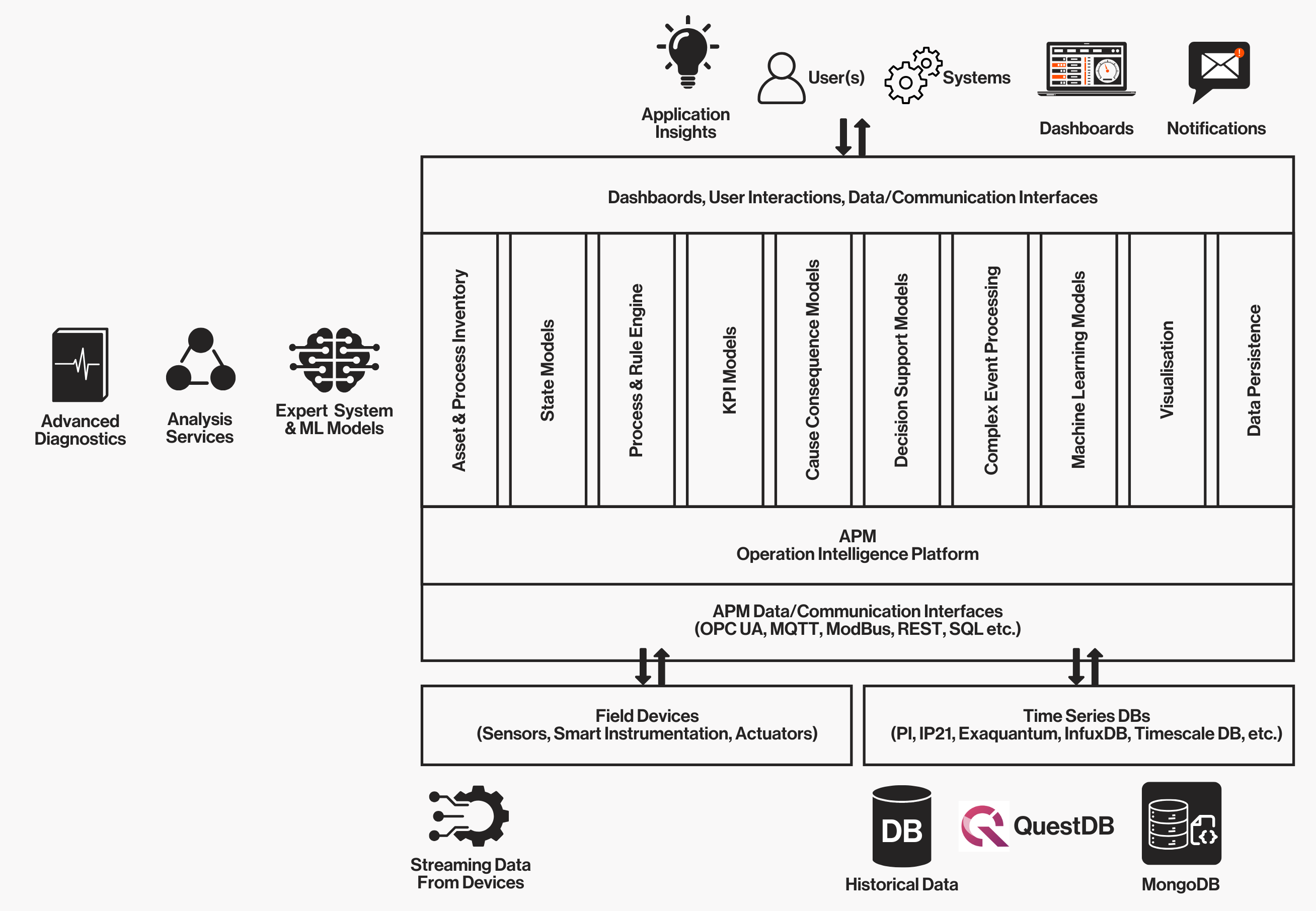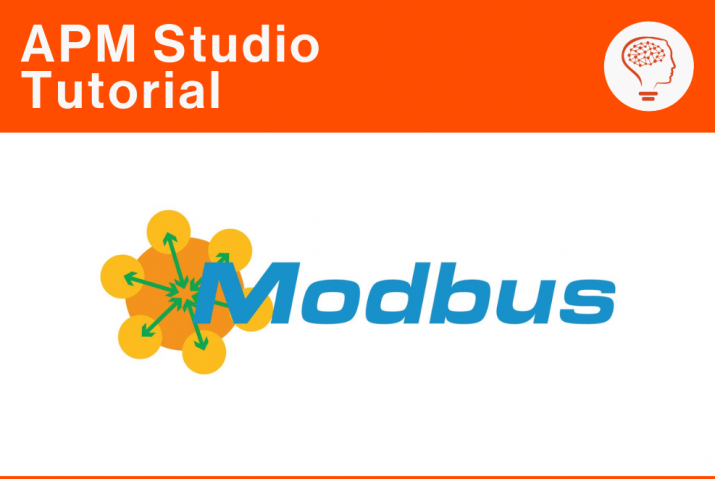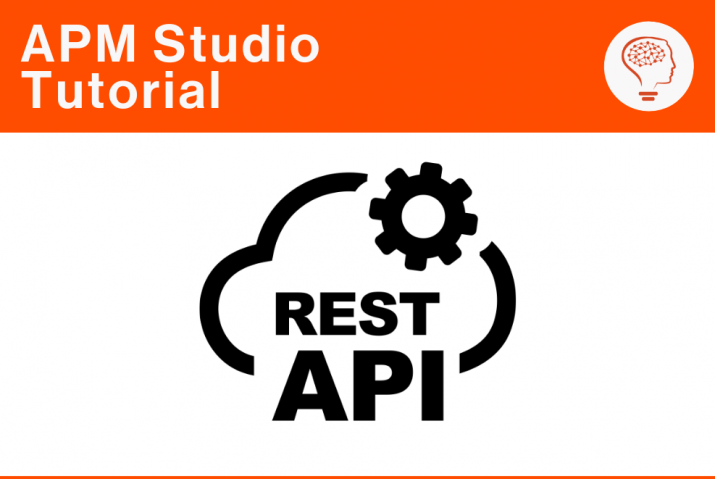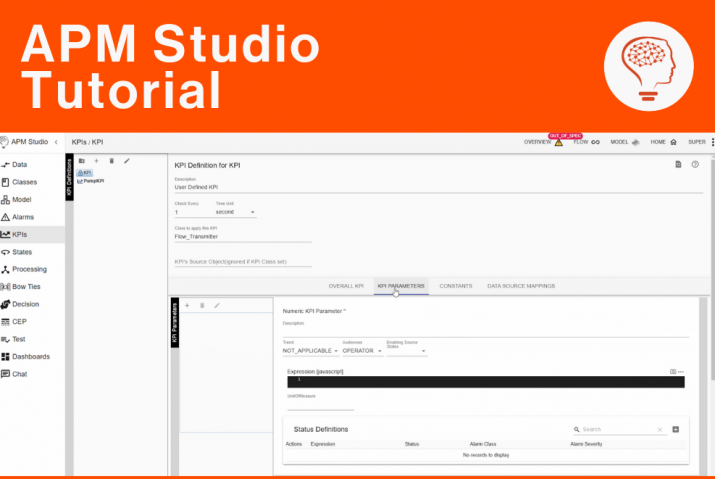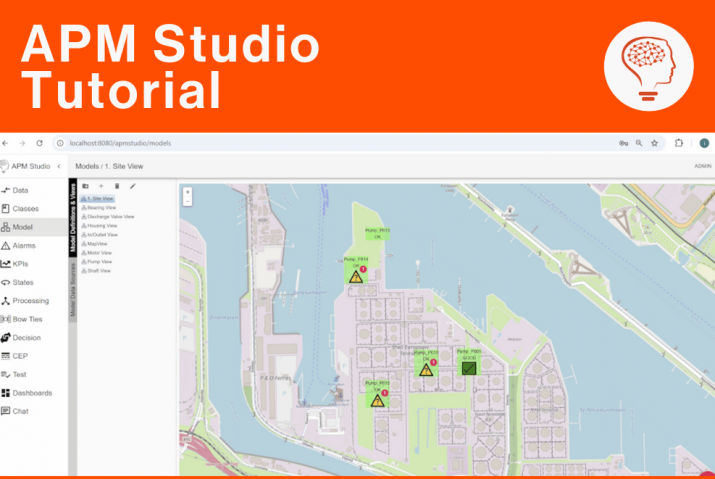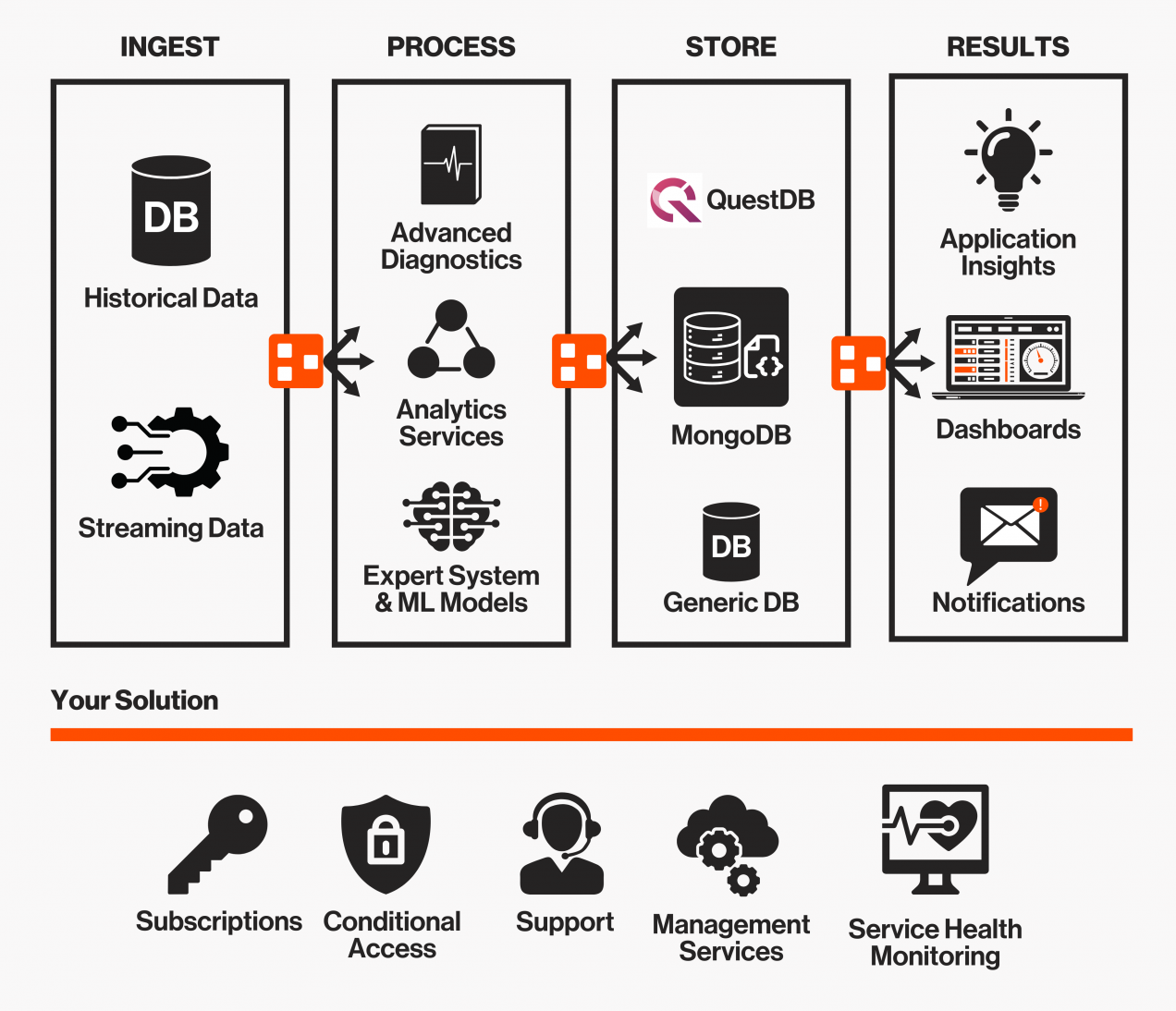
What is APM Studio?
A low-code platform that enables OEMs, asset owners, and service providers to build and deploy industrial applications quickly — without traditional software development’s complexity, cost, and time-consuming processes. By combining real-time data ingestion, semantic modelling, and advanced analytics (ML, Bowtie cause-consequence, deterministic logic) in one environment, APM Studio lets you digitize your domain expertise, analyse real-time data, and deliver branded, IP-protected solutions. These solutions can be white-labelled and embedded into your existing products or services, expanding your market offering while preserving your own brand identity.
Beyond optimizing the development process, APM Studio’s containerized architecture (Docker, Kubernetes) and multi-architecture support (x86, ARM32/64) allow you to deploy the same robust analytics pipeline on embedded devices, on-premises servers, or in the cloud. This ensures consistent, real-time monitoring, diagnostics, and predictive analytics capabilities across different infrastructure setups. Whether you aim to set up a new service for thousands of remote devices or enhance a single asset with local intelligence, APM Studio provides the scalability, flexibility, and ease of use that technical teams need to achieve rapid and sustainable digital transformation.
Data Connectivity Made Easy
APM Studio offers standard interfaces to connect with control systems, PLCs, historians, databases, enterprise systems, and cloud platforms—supporting both real-time and historical data flows for seamless integration.
Learn more …
Build for Scale
APM Studio uses Classes and Objects to standardize data across assets, making it easy to replicate applications and scale deployments consistently across multiple locations.
Learn more …
Process & React
Integrate AI, logic, and FMECA-linked Bowtie models into one workflow to assess risk, detect issues in real time, and support smarter maintenance and operations.
Learn more …
Integrate to External Systems Easily
Easily integrate APM Studio with external systems via microservices or protocols like AMQP and MQTT, supporting both UI-based and headless deployments.
Learn more …
Visualize in Web-Based Real-Time Dashboards
Quickly create role-specific dashboards with real-time data, historical trends, and automated reports—or seamlessly integrate insights into Power BI or Grafana using APM Studio's REST API.
Learn more …
Built-in Alarm & Event Management
Detect anomalies, trigger diagnostics, and leverage real-time Complex Event Processing (CEP) to correlate events and alarms for deeper insights.
Learn more …
White Label Your Solution
Deploy APM Studio analytics seamlessly within your own applications, dashboards, or branded interfaces—ensuring consistent branding and advanced condition monitoring behind the scenes.
Learn more …
Run Anywhere On-Premises or in the Cloud
Deploy diagnostic and prognostic models seamlessly on-chip, at the edge, or in the cloud with APM Studio’s flexible, containerized architecture, ensuring consistent performance everywhere.
Learn more …
Built-in Security
APM Studio ensures data integrity, reliability, IP protection, and robust cybersecurity—essential for industrial and enterprise environments.
Learn more …
Its low-code environment has drastically reduced our development time, while still giving us the flexibility and depth we need.
For six years, we’ve been using the embedded version of APM Studio on our device. Within APM, we develop all diagnostic and control functionalities. One of the new features we made in APM is on-the-spot report generation for real-time trend analysis and insights.
Beyond embedded use, we also apply APM Studio in parts of our production automation. The built-in dashboards and solid I/O handling of several external systems with various communication protocols make it a reliable choice there too.
With regular software updates, APM continues to evolve alongside our needs. It’s a powerful and flexible platform.

Stefan van Caspel
How It All Connects
APM Studio Interactive Demos
Browse all interactive demos here
APM Studio Tutorials
Whether you’re just getting started or looking to deepen your expertise, these step-by-step guides will help you unlock the full potential of APM Studio. Learn how to set up predictive maintenance models, analyze asset data, and optimize your maintenance strategies with practical, hands-on tutorials. Each tutorial is designed to provide clear explanations and real-world examples, so you can start applying insights to your operations right away. Ready to enhance your skills? Let’s dive in!
Browse all tutorials here
-
Tutorial 01/30/2025
Creating Classes
This article explains the concept of Digital Twin, what a Digital consists of and how you can implement it in solving maintenance and operations problems.
Read more -
Tutorial 01/31/2025
Set-up of a Modbus TCP Master in APM Studio
This article explains the concept of Digital Twin, what a Digital consists of and how you can implement it in solving maintenance and operations problems.
Read more -
Tutorial 02/04/2025
Set-up of a REST Call in APM Studio
This article explains the concept of Digital Twin, what a Digital consists of and how you can implement it in solving maintenance and operations problems.
Read more -
Tutorial 01/29/2025
Set-up of an OPC UA Client in APM Studio
This article explains the concept of Digital Twin, what a Digital consists of and how you can implement it in solving maintenance and operations problems.
Read more -
Tutorial 02/19/2025
Setting up KPIs in APM Studio
This article explains the concept of Digital Twin, what a Digital consists of and how you can implement it in solving maintenance and operations problems.
Read more -
Tutorial 02/18/2025
Using the Map View for Objects in APM Studio
This article explains the concept of Digital Twin, what a Digital consists of and how you can implement it in solving maintenance and operations problems.
Read more
Ready to take the first step?
Book a call with Artur Loorpuu, Senior Solutions Engineer in Digitalization. Artur specialises in turning industrial challenges into practical digital solutions through expertise in predictive maintenance, digital twins, data science, and strategic product management.
Let’s explore how we can support your goals!
.
.
Compare plans
Choose one of the three options and find what fits for you.
Data Interfaces
APM Studio Basic
APM Studio Premium
APM Studio Enterprise
CSV
File based access to Comma Separated Value files. Especially helpful for testing, validation and scenario re-enactment (playback) of past events in history
REST
Allowing you to set-up REST end-points and REST connectors to systems such as SAP/Maximo/Teams/ThingWorx/UpKeep etc.
SOAP
Allowing you to use SOAP (Simple Object Access Protocol), which is a message protocol that enables the distributed elements of an application to communicate.
ModBus (Master/Slave)
APM Studio comes with an in-built Modbus interface that can be a Master or Slave. The Modbus protocol exchanges information using a request-reply mechanism between a master (client) and a slave (server).
Netilion
APM Studio can easily connect with Endress+Hauser's Netilion. Netilion Health is a digital asset-health management service that puts your maintenance team a step ahead of problems. It provides diagnostics from your field devices anywhere at any time, so you can have remedies ready when you need them.
OI4 OEC (MQTT)
Allows you to easily connect Open Industry 4.0 OEC MQTT protocol adopted by front-runners in the industry.
SQL Database
SQL database or relational database can be accessed in tailing or query mode by APM Studio allowing you to connect to a wide variety of data sources such as Microsoft SQL Server, Oracle, MySQL et cetera.
OPC UA Client
APM Studio provides OPC UA Client interfacing meaning that it can subscribe easily to OPC UA Servers to access data and information.
Azure Blob Storage
Azure Blob storage is Microsoft's object storage solution for the cloud. APM Studio has Azure Blob storage in-built interface for easy integration.
Profinet
APM Studio supports Profinet (usually styled as PROFINET, as a portmanteau for Process Field Network) which is an industry technical standard for data communication over Industrial Ethernet, designed for collecting data from, and controlling equipment in industrial systems, with particular strength in delivering data under tight time constraints.
OPC UA Server
APM Studio can act as an OPC UA Server. The information provided by an OPC UA Server is organized in the Server Address Space. Services like Read, Write and Browse are available with a request/response pattern used by OPC UA Clients to access information provided by an OPC UA Server.
OPC UA Pub/Sub
APM Studio supports OPC UA Pub/Sub model. In the PubSub model, we have a Publisher component, which can define DataSets that contain Variables or EventNotifiers. The Publisher will then publish DataSetMessages, which contain DataChanges or Events, respectively.
Data Transformation/ Enrichment
APM Studio Basic
APM Studio Premium
APM Studio Enterprise
Aggregation
APM Studio allows you to aggregate data from different data sources and provide statistics such as average, minimum, maximum, sum, and count. After the data is aggregated and written to a view or report, you can analyze the aggregated data to gain insights about particular resources or resource groups.
Attribute Construction
With APM Studio it is possible to apply data transformation operations to the original attributes to create new attributes whose predictive power is greater than the original attributes.
Discretization
APM Studio is enabling discretization which is the process of transferring continuous functions, models, variables, and equations into discrete counterparts.
Generalisation
APM Studio enables easy data integration by combining data from different sources into a single, unified view. Data integration ultimately enables analytics tools to produce effective, actionable business intelligence.
Integration
APM Studio enables easy data integration by combining data from different sources into a single, unified view. Data integration ultimately enables analytics tools to produce effective, actionable business intelligence.
Math functions
With APM Studio you can easily use math functions to work with your data to gain better insights.
Statistic functions
APM Studio has in-built support for statistic functions like standard deviation, mean, median and many more to help you build better analytics on your data.
Semantic Modelling
APM Studio Basic
APM Studio Premium
APM Studio Enterprise
Classes
Classes in APM Studio act as a template that specifies what objects will look like and what properties they have, a digital representation of your real world asset that can be scaled over 1000's of assets.
Object Models
Digital copies of your real-world assets that you can run analytics, algorithms and intelligence on.
Auto Generated Object Models
APM Studio can auto-generate model objects from the data stream, meaning that you can easily create copies of thousands of assets effortlessly.
State Models
APM Studio enables you to mimic asset behaviour with the usage of State Models that can be then used for more complex analytics.
Reasoning
APM Studio Basic
APM Studio Premium
APM Studio Enterprise
Cause-Consequence Models
Bowties are cause-consequence models that assist in the early identification and management of risks and unwanted events. BowTie diagrams give an overview of multiple plausible scenarios in a single picture. With bowties, the probabilities of unwanted events are continuously tested on the data streaming in.
Fuzzy Models
APM Studio supports Fuzzy Logic which is a reasoning method that is similar to human reasoning where a situation or state cannot simply be determined as true or false but by a number of intermediate values.
Decision Support
You can set up direct interaction with end-users of your APM application by creating Decision Support Rules. These decision support rules can reference states and conditions of your processes and specific individual assets. Decision support rules act as prescriptive guidance to your maintenance personnel, instructing them with specific steps and actions.
Complex Event Processing
CEP Engine that combines events/alarms from multiple sources to infer new events that describe patterns or other complicated causal relationships (circumstances). Event patterns and relationships are set up via a comprehensive UI in APM Studio.
Machine Learning
APM Studio Basic
APM Studio Premium
APM Studio Enterprise
Association rules
Association rule learning is a rule-based machine learning method for discovering interesting relations between variables in large databases. It is intended to identify strong rules discovered in databases using some measures of interestingness.
Cluster Model
Clustering models allow you to categorize records into a certain number of clusters. This can help you identify natural groups in your data. Clustering models focus on identifying groups of similar records and labeling the records according to the group to which they belong.
General Regression
The General Regression Models (GRM) module is called a "general" regression program because it applies the methods of the general linear model, allowing it to build models for designs with multiple-degrees-of-freedom effects for categorical predictor variables, as well as for designs with single-degree-of-freedom effects for continuous predictor variables.
Naive Bayes
Naive Bayes classifiers are a family of simple "probabilistic classifiers" based on applying Bayes' theorem with strong (naive) independence assumptions between the features.
k-Nearest neighbours
The k-nearest neighbours (KNN) algorithm is a simple, supervised machine learning algorithm that can be used to solve both classification and regression problems.
Neural network
A neural network is a series of algorithms that endeavours to recognize underlying relationships in a set of data through a process that mimics the way the human brain operates. In this sense, neural networks refer to systems of neurons, either organic or artificial in nature.
Regression
Regression analysis is a set of statistical methods used for the estimation of relationships between a dependent variable and one or more independent variables. It can be utilized to assess the strength of the relationship between variables and for modelling the future relationship between them.
Rule set
You can use data rule definitions or rule set definitions to create rule logic to evaluate your data. When you build rule logic, you can either create individual data rule definitions or rule set definitions.
Scorecard
A data mining model that can predict target values in characteristics (such as Remaining Useful Lifetime, Risk of Failure).
Support Vector Machine
Support vector machines (SVMs, also support vector networks) are supervised learning models with associated learning algorithms that analyze data for classification and regression analysis.
Tree model
Decision Tree Learning is a supervised learning approach used in statistics, data mining and machine learning. In this formalism, a classification or regression decision tree is used as a predictive model to draw conclusions about a set of observations.
Ensemble model
Ensemble methods use multiple learning algorithms to obtain better predictive performance than could be obtained from any of the constituent learning algorithms alone.
Numpy
NumPy is a very popular python library for large multi-dimensional array and matrix processing, with the help of a large collection of high-level mathematical functions. It is very useful for fundamental scientific computations in Machine Learning. It is particularly useful for linear algebra, Fourier transform, and random number capabilities. High-end libraries like TensorFlow use NumPy internally for the manipulation of Tensors.
SciPy
SciPy is a very popular library among Machine Learning enthusiasts as it contains different modules for optimization, linear algebra, integration and statistics. There is a difference between the SciPy library and the SciPy stack. The SciPy is one of the core packages that make up the SciPy stack. SciPy is also very useful for image manipulation.
Scikit-learn
Scikit-learn is one of the most popular ML libraries for classical ML algorithms. It is built on top of two basic Python libraries, viz., NumPy and SciPy. Scikit-learn supports most of the supervised and unsupervised learning algorithms that can easily be integrated into your APM-Studio solution.
Theano
Theano is a popular python library that is used to define, evaluate and optimize mathematical expressions involving multi-dimensional arrays in an efficient manner.
TensorFlow
TensorFlow is a very popular open-source library for high performance numerical computation developed by the Google Brain team in Google. As the name suggests, Tensorflow is a framework that involves defining and running computations involving tensors. It can train and run deep neural networks that can be used to develop several AI applications. TensorFlow models of deep learning research can easily be integrated into your APM-Studio solution.
Keras
Keras is a very popular Machine Learning library for Python. It is a high-level neural networks API capable of running on top of TensorFlow, CNTK, or Theano. It can run seamlessly on both CPU and GPU.
Pytorch
PyTorch is a popular open-source Machine Learning library for Python based on Torch, which is an open-source Machine Learning library that is implemented in C with a wrapper in Lua. It has an extensive choice of tools and libraries that support Computer Vision, Natural Language Processing(NLP), and many more ML programs. It allows developers to perform computations on Tensors with GPU acceleration and also helps in creating computational graphs.
Pandas
Pandas is a popular Python library for data analysis. It is not directly related to Machine Learning. As we know that the dataset must be prepared before training. In this case, Pandas comes handy as it was developed specifically for data extraction and preparation. It provides high-level data structures and wide variety tools for data analysis. It provides many inbuilt methods for grouping, combining and filtering data that can be directly used in APM Studio solutions.
Matplotlib
Matplotlib is a very popular Python library for data visualization. Like Pandas, it is not directly related to Machine Learning. It particularly comes in handy when a APM Studio developer wants to visualize the patterns in the data. It is a 2D plotting library used for creating 2D graphs and plots that can easily be integrated into PDF outputs of APM Studio solutions.
Visualization
APM Studio Basic
APM Studio Premium
APM Studio Enterprise
Asset Cards
Asset Cards allow you to display health, KPI status information and property values of an asset in a single dashboard component - enabling you to see critical information in one glance
Time Series Charts
APM Studio allows you to easily visualize timeseries data along with event data on the chart - combining event data with timeseries data for a complete overview on one graph
Pie Charts
Pie charts allow you to visualize and illustrate numerical proportions of wanted information easily
Radar Charts
Radar charts allow you to display multivariate data in the form of a two-dimensional chart of three or more quantitative variables represented on axes starting from the same point.
XY Charts
XY (Scatter) charts plot two groups of numbers as one series of XY coordinates.
Gauge
Gauges allow you to display instantaneous values from your real-time data sources in your customized dashboard with APM Studio.
PDF Reporting
APM Studio allows you to easily create PDF reports that can be sent out to relevant personnel (maintenance technicians, managers and directors etc) automatically. Reports support tabular information, textual, and graphs generated in the APM Python server.
Data Persistence
APM Studio Basic
APM Studio Premium
APM Studio Enterprise
Time Series Database
APM Studio comes with in-built timeseries database (QuestDB) that allows you to persist and access your data over long periods of time. Fast accessibility allows you to run complex intelligence, Machine Learning models and algorithms efficiently over historical data, delivering instantaneous value.
Smart Objects
APM Studio Basic
APM Studio Premium
APM Studio Enterprise
Control valve
UReason has developed Control Valve Smart Object containing pre-defined properties, intelligence, algorithms and cause-consequence models that will speed up your solution development and deployment.
Centrifugal Pump
UReason has developed Centrifugal Pump Smart Object containing pre-defined properties, intelligence, algorithms and cause-consequence models that will speed up your solution development and deployment.
Filter
UReason has developed Filter Smart Object containing pre-defined properties, intelligence, algorithms and cause-consequence models that will speed up your solution development and deployment.
Heat Exchanger
UReason has developed Heat Exchanger Smart Object containing pre-defined properties, intelligence, algorithms and cause-consequence models that will speed up your solution development and deployment.
Compressor
UReason has developed Compressor Smart Object containing pre-defined properties, intelligence, algorithms and cause-consequence models that will speed up your solution development and deployment.
Turbine
UReason has developed Turbine Smart Object containing pre-defined properties, intelligence, algorithms and cause-consequence models that will speed up your solution development and deployment.
Development
APM Studio Basic
APM Studio Premium
APM Studio Enterprise
Testing
In the project, inside APM application, a testing framework allows you to create test scenarios, sequences, and actions to be performed during tests, see the expected results, run/control tests, visualize the results, and download test reports. Plus provides interfaces via REST API for on-demand test execution triggered from external systems.
Debugging
APM Studio comes with an in-built debugging function that allows you to oversee and debug your built processing algorithms, enabling you to detect logic faults easily and effectively.
Versioning
With APM Studio you can use versioning of projects easily which allows total control over the development process of your solutions.
Cross-platform exchange
An APM project can be exported on any platform (to a UAA - Ureason Application Archive) and imported on target hardware (amd64, arm32, arm64) and OS (Windows/Linux)
Chat
APM Studio provides a Chat interface that allows developers to query the object model for occurrences of events, values of properties on objects et cetera.
Full REST API Access
APM Studio comes with Full REST API access allowing APM to run "headless" - run intelligence and processing in the background server and then provide insights to your existing infrastructure seamlessly.
Deployment
APM Studio Basic
APM Studio Premium
APM Studio Enterprise
amd64
Deployment of APM and APM Studio is supported on amd64 (x86-64/x64).
arm32
Deployment of APM and APM Studio is supported on arm32 as Docker.
arm64
Deployment of APM and APM Studio is supported on arm64 as Docker.
Kubernetes
When APM is deployed for large asset bases we provide middleware for automatic deployment, scaling and management using Kubernetes.
Experience the Power of Combining Data and Industry Expertise
Book a free demo to see APM Studio in action. We will get back to you as soon as possible after receiving your form.
Cookies Policy Preferences
We place functional cookies to make our website function properly, analytical cookies to measure the use of the website and tracking cookies to make your experience on the website even better.
These cookies are necessary to make the website work. Without these cookies some preferences (such as language settings) cannot be stored. We use the functional cookies to effect the session with the server, to check whether a form really comes from the website, to remember your cookie status.
We use analytical cookies to review the quality and effectiveness of our website. This way we can see how many visitors we get to the website and what pages they visit. This information is used by us to analyze and improve our website.
We ask your permission to install tracking cookies of the parties stated below to allow us to show you appropriate and relevant content on our website. Based on the pages you visited, they show ads these parties believe to be interesting to you. We do not have any control of the cookies of third parties and the way in which they install tracking cookies. We do not have access to the data collected by third parties.
